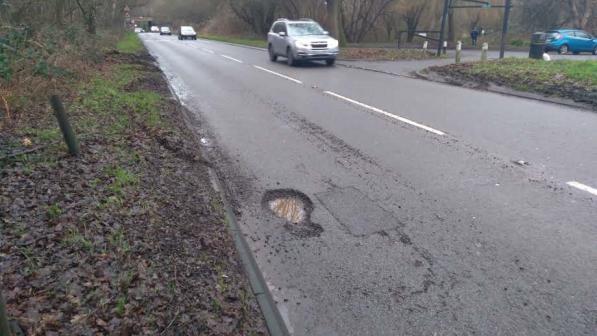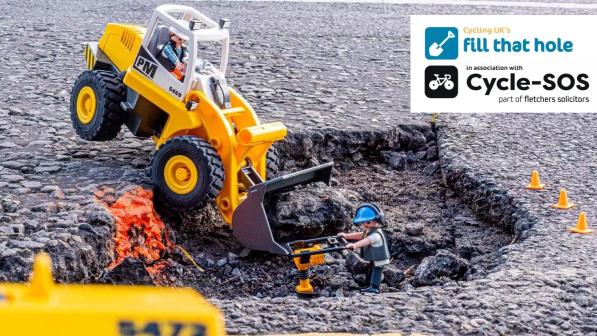What should I do if I hit a pothole?

Are you still in danger? – make yourself safe!
When toppled from your bicycle, your first priority is to avert further danger to yourself. If unable to move out of harm’s way, then shout, wave or whistle to attract assistance.
Emergency assistance
In an emergency, always telephone 999 for an ambulance if you need them; this call will be logged and can be very useful evidence subsequently. [Note too the European-wide, and increasingly international standard emergency number 112, which can be placed on your mobile contacts list]. If you are injured but don’t need an ambulance, you can call 111 and they will give you advice and direct you to call 999 if necessary. For less serious injuries, seek assistance from A&E or your GP.
Evidence
If you are able, it’s important to gather as much evidence at the scene as possible.
Ideally, take photos of the pothole and note down measurements (estimated if necessary), including width, length, depth and position on the road. Include something in the photo to show scale, for example a coin, bank card or pen.
If you aren’t able to take photos and gather evidence due to injury, try to ask a passer by to do so and exchange details. Make sure to communicate to them the importance of the photos as evidence.
Make sure to reference the exact location of the hole if possible, especially if there are multiple potholes on the road. Mark the point on a map and use photos of road signs or other fixed landmarks as reference.
Back up and securely store any photos or videos you take, ideally in two separate locations.
If you think there may have been any CCTV which recorded the incident, try to obtain a copy as soon as possible, as these films are often quickly deleted.
If it is impossible to take photos immediately after the incident, return as soon as feasibly possible – as returning too late may mean the pothole has been filled or that the photos are no longer valid evidence.
Independent witnesses
Part of the problem is proving that it was a pothole that caused the incident, and an independent witness can help with this – try and get their contact details if possible. If someone stops to ask if you are ok, it’s very easy to say ‘yes’ and wave them on, but instead you should ask them to stop and get their details so they can become a witness.
If you’re cycling in a group, unfortunately, your pedalling pals will not count as independent witnesses, although their accounts may still be useful.
Ask all witnesses to write down their account as soon as possible and to include as much detail as they can remember, and to sign and date it. This will make it more credible, as details can be quickly forgotten.
Injuries
Never shrug off any injuries, but insist on a check-up, either with your GP or via a walk in A&E centre, and seek medical attention for any subsequent twinges, as too often injured cyclists ‘soldier on’ and take even longer to heal up. Get good photographs of bruises and lacerations; do not be shy about this and get a friend to take them showing change over days and weeks if you can’t get a good photo yourself. Maintain a detailed record of all expenses, e.g. for prescription charges, bus and taxi fares, hospital parking fees and painkillers.
If you aren’t injured
Even if you aren’t injured, you will likely be in shock. Once you have made yourself safe and gathered the contact details of witnesses, take some time to let the adrenaline pass, and don’t let yourself get cold. Be aware that you may be concussed. If you think you might be concussed seek medical advice as soon as possible and don’t attempt to ride.
If you are unable to get picked up and decide to continue your ride, make sure to check over your bicycle first to ensure it is safe and fully functional, especially the brakes, wheel and forks.
If there are any cracks in the wheel, forks or frame, the bike shouldn’t be ridden until looked over by a professional mechanic.
Property damage
Do not forget potential compensation for damage to your bicycle, panniers and clothing. Get good photographs of the damage and keep all damaged items. Keep all receipts for any repairs and, if the cost is going to be above £100, get two quotes.
Inform the police
Even if there is no emergency, for anything other than very minor collisions, you should still report the matter to the police as soon as possible, and within 24 hours at the latest. This will help with police records and keep other cyclists safe. Keep note of any reference number they give you and note down the name of the person you speak to.
Instruct a specialist solicitor
Unfortunately, not all lawyers are experts in personal injury litigation and negotiations with insurers can sometimes be protracted. If you are a Cycling UK member you should use our legal helpline to seek advice.
If you aren’t a member, you may wish to look for solicitors who will work on contingent fee arrangements – ‘No Win, No Fee’. For these solicitors, you will not need to pay money up front and will only ever pay anything if you are successful. Different solicitors will have different arrangements, so make you fully understand any contract before you sign it.
Help your solicitor by keeping a ‘Pain Diary’ of your symptoms or an ‘Experience Diary’ detailing any pain, irritation or annoyance resulting from your injuries.
Report the pothole
Make sure to report the pothole to the relevant Highway Authority (usually the borough or city council) as soon as possible, even if you have not yet put in a compensation claim (although make sure you have photos etc. of the pothole first!). This will ensure that the council are aware of the pothole and will fill it in to protect other cyclists.
You can use Cycling UK’s Fill That Hole tool (see how in the side bar) to quickly and easily report a pothole to the relevant authority. More generally, you should always report potholes whenever possible – this ensures a council is aware of the pothole and has an obligation to inspect it, and will help other cyclists who may have to make their own compensation claim.







